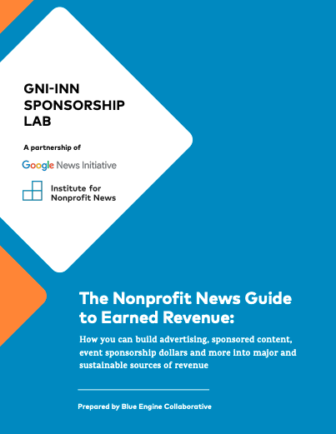 Google News Initiative and INN today released the Nonprofit News Guide to Earned Revenue — a comprehensive "playbook" showing nonprofit newsrooms how to grow revenue from display advertising, event sponsorships, sponsored content, and other earned revenue sources.
Google News Initiative and INN today released the Nonprofit News Guide to Earned Revenue — a comprehensive "playbook" showing nonprofit newsrooms how to grow revenue from display advertising, event sponsorships, sponsored content, and other earned revenue sources.
This first-of-its-kind resource is the latest output from the GNI-INN Sponsorship Lab, which earlier this year produced two case studies on INN members: How The San Antonio Report Generates Three Times More Revenue than the Average Nonprofit Newsroom and How Madison365 Stays True to Its Mission While Earning More than Half Its Revenue from Businesses.
The Nonprofit News Guide to Earned Revenue was written by NJ Spotlight’s Steve Shalit and Emily Roseman (who recently joined INN as research director) on behalf of Blue Engine Collaborative, a new consortium of independent consultants and advisers with deep experience in driving audience and revenue at for-profits and nonprofits.
The impetus for the guide came out of data from INN’s 2020 Index indicating that earned revenue makes up, on average, just 11% of reporting members’ total revenue. Compare this to standout statewide outlets like the Texas Tribune and NJ Spotlight, who have grown earned revenue to about one-third of their overall revenue, and it is apparent that nonprofit news organizations have an enormous, largely untapped opportunity to dramatically grow their earned revenue.
Here are four key takeaways from the guide:
Sell solutions. Identify needs and offer solutions for partners. News outlets that had success with earned revenue figured out how to align their financial goals with the interests of their community members, including local business owners. For example, the San Antonio Report created a business membership that offers an opportunity for companies to underwrite relevant content and receive recognition without placing advertisements.
View local businesses as partners and allies. Relationships with sponsors and prospects aren’t transactional. Newsrooms should foster a connection with them. Just as nonprofit journalism is service-oriented, so are these partnerships. Take for example Madison365, which created a program promoting its mission of producing coverage specifically for communities of color to find potential sponsors who support that goal.
Get the tech stack right. Even the best people and strategies can fall short with a weak foundation. In the guide, we review the basic tools newsrooms should consider, such as content management systems, ad servers and virtual event technology, and discuss how these systems should work together in a way where data collected now can be cleanly imported into a more advanced tech stack down the road.
Develop (and improve!) an efficient work flow. Nonprofit news organizations are often small and scrappy—they work smarter, not harder. For example, we look at NJ Spotlight’s process for deciding which sales to chase, and which to let go. Here’s how it works: Log all interactions with clients and categorize each prospect with either a “90” (likely to convert, so drop everything to make this sale), 50 (possible to convert, spend some of time here), or 10 (remember this contact, but move on for now).
INN is putting this playbook’s best practices to work as the core curriculum of the GNI-INN Sponsorship Lab. Launched in October, the six-month program is providing coaching to support a diverse group of eight nonprofit publishers as they develop and improve their earned revenue streams over time: Block Club Chicago, Cityside, The CT Mirror, Current, Futuro Media, Grist, Salt Lake Tribune and VTDigger. Stay tuned for lessons learned in 2021!
Read what INN's Chief Knowledge Officer Fran Scarlett had to say about this initiative on Google's Keyword blog.
